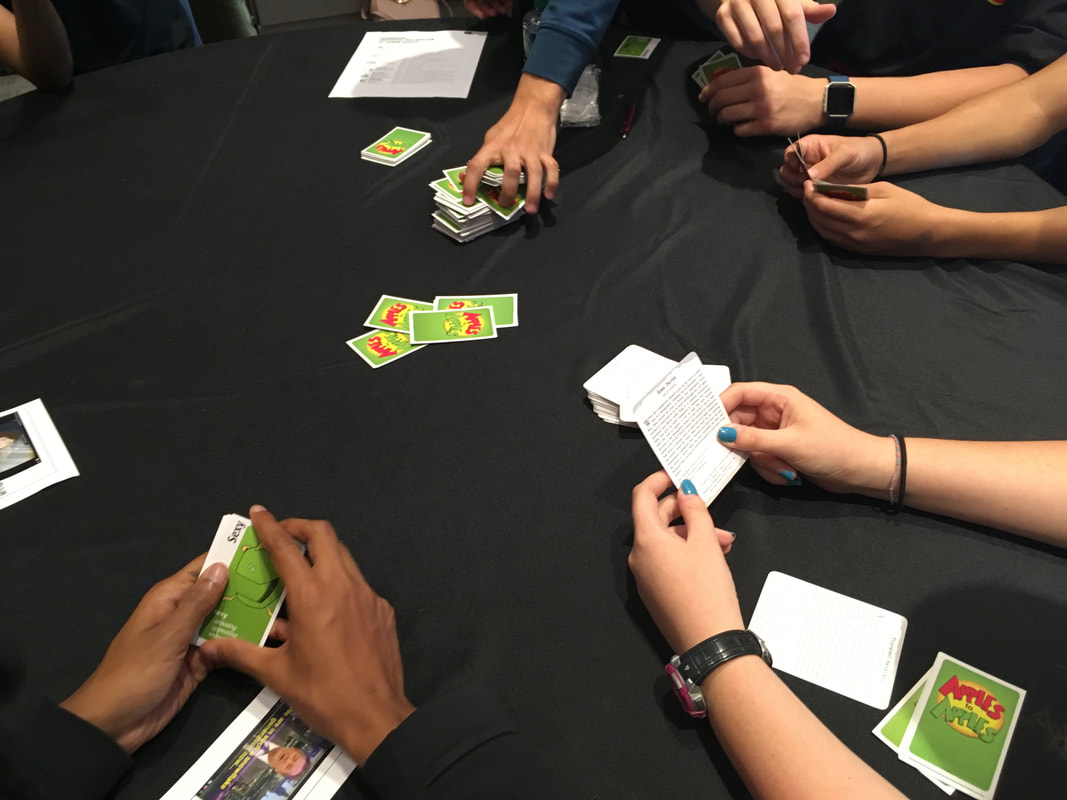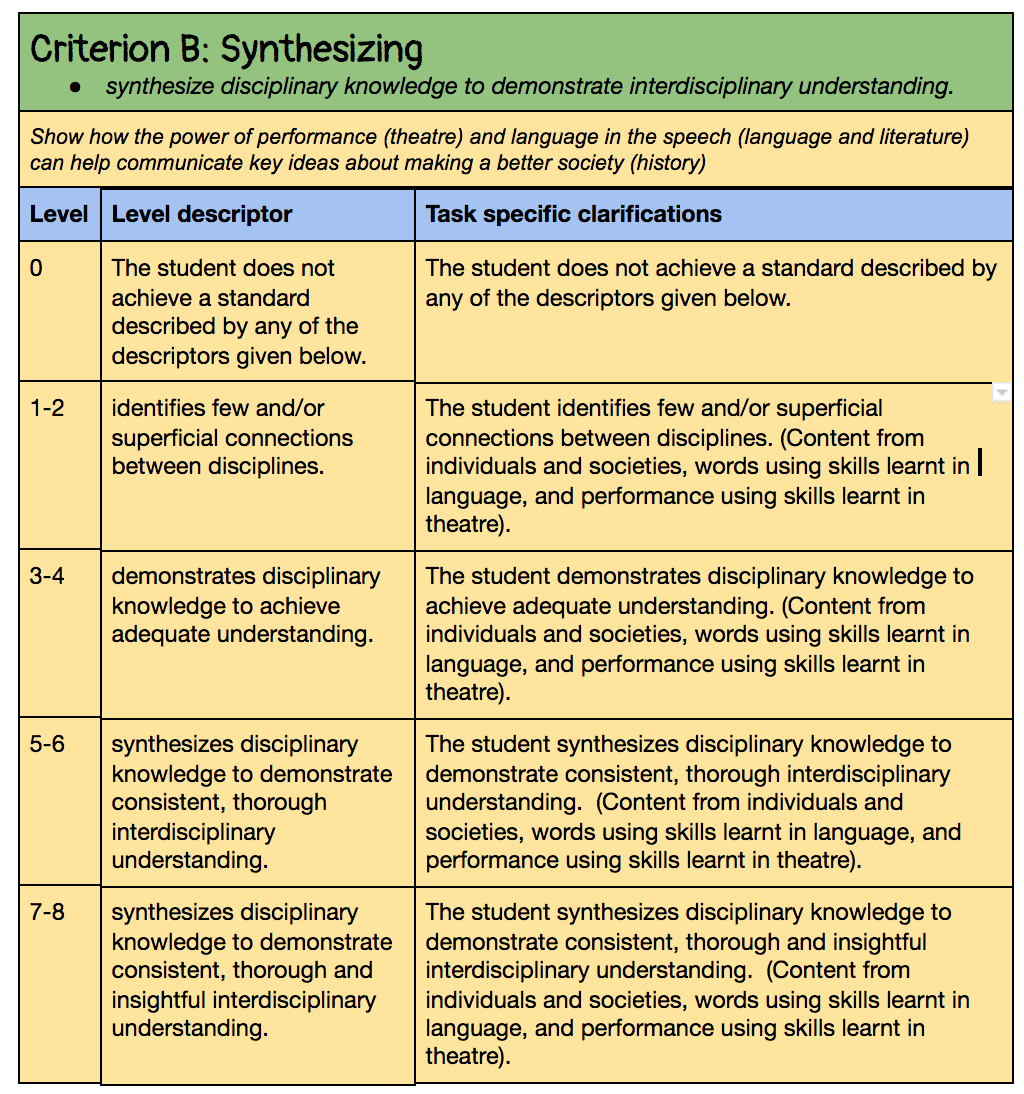|
IDU overview, Day One and Day Two. We started off in the theatre space, reflecting on the day before and answering questions, then students spent the next four hours working in their groups, to complete their script, bibliography, presentation and to rehearse! We had split the students up into different locations, with different teachers supervising....but there was very little for us to do! The students were engaged and focussed. It was lovely to walk around and hear their ideas and see the topics they had chosen. Topics included; freedom from torture, No unjust detention, imprisonment or exile, religious freedom, gun laws, immigration, freedom of the press, child slavery, "take a knee", abortion, death penalty, domestic abuse and more. In the afternoon students met back in our theatre space and performed! We were blown away with the high quality work students produced in such a short time! At the end we did a feedback session, and some of the students said they wish it had a bigger audience - I asked them if I could share their videos online, and they agreed....so, here are a selection Grading - As it was the end of the year (the students had a half day the next day only) and grading had been one of the things which put teachers off doing IDUs the most, we made it as simple as possible! During, or after each performance, teachers could fill in a Google Form, which would ask for a 1-8 grade for Criterion B and C, and also had space for comments. If you are curious, here is a copy of the form. I assigned different teachers, different groups, but said if they wanted to add additional feedback for a group they were not assigned they could. After school I created a doc for each group, which had a link to the video of their performance, as well and the grades and comments. I put in all the number grades, then made a best fit judgement: We kept it casual and informal, as this is our pilot group. Next year grades and comments will be on ManageBac, and they will get an IDU grade(s) on their report card at the end of the year. Example: At the end of the day we were able to reflect with the students. They talked about the IDU being very valuable, challenging and fun, and also gave us some tips for feedback next year. I am moving to a new school next year, so someone else will take over as the lead on this, but they should not be too much to tweak. Some main ideas: Move the IDU between semester two and three and to narrow down the topic, for example tell students they need to talk about human rights violations that many people do not know about, or maybe unheard perspectives. I am sad to not be apart of this next year, as it was so much fun, but know it will continue growing and evolving wonderfully!
Students then split into three groups and rotated through different workshops:
My workshop had students look at a couple of Human Rights and Amnesty International Videos, (we also added one, by request, about the Rights of the Child). Students then watched my, rather dry, attempt at a 10x15 pecha kucha, explaining the IDU. They then watched a few proper examples.
At the end of the session students let me know who they wanted to work with. Groups had to be made of three or four students, but they could choose who they wanted to work with (this worked really well, and students fed back to us that they liked this).
After lunch students were split into five different rooms, and had time to decide on their topic and start researching! You can see an overview of our Grade 10 interdisciplinary unit on Human and Civil rights here. Day One! We headed off the wonderful Center for Civil and Human Rights. We were granted access before the museum opened to the public, and had booked the function room for afternoon activities. Our first activity was run by our wonderful theatre teachers, Mr Bell and Ms Weeks. They had students move around the space, then would randomly call out 'get into a group of 4' or 'get into a group of 8', then they would give them a word to physicalize. These words included; Social Conflict, Violation, Privilege, Human Rights, Exploitation, Moral Principles, Segregation, Freedom of Expression/Thought, Justice and Humiliation. These words would be used later in the day too! The rest of the morning included a tour from Ted Ward from the center. I can not speak highly enough about him - he had a wonderful way with the students and really told them stories that they connected to. I had briefly mentioned to him through email that they were looking at human and civil rights around the world, and we wanted them to look at a range of different perspectives - he knew exactly what I meant, and highlighted stories of everything from Latino to LGBTQ activists. I spent most of the time in the function room setting up for the afternoon, but was able to see him talking to the students about the Aids Memorial Quilt and joined them for the end of the tour. If you are a school in the south east, I cannot recommend this tour and center enough! Get there now! After the tour, and after lunch, we looped back into the initial activity (physicalizing those words), by doing a PZ activity called Making Meaning:
After this group activity, we set up different activities at every table. Students would all start off at one time and would spend around 20 minutes there. We would then let them know to move tables. They did not rotate, but could choose where they moved each time. We had 11 tables, each with an activity, and we had some spare activities we swapped out at times too - meaning that all students would not make it to all activities. As we gave them a little summary of the activities at the start, they could move to the tables that interested them most. Here are a description of some of the activities - along with some photos. This is America. This station at two parts. One had questions about the Childish Gambino Video This is America. The next part had students answer "what does the phrase 'this is America' mean to you?" Poster Discussion. The next table, manned by Ilse Ortega, had students look at three different Amnesty International Posters. We had questions translated into German, Spanish and English for each poster. This table worked well, as it had a teacher leading the discussion. We could have separated the activities by languages, or had students respond to them silently, (Chalk Talk style)! Here and the questions and translations. Apples to Apples and Pictionary! Tim McMahon planned two tables, which were set out as games. One was a spin on the classic American game, Apples to Apples, where students would read out the description from a card from a deck of civil rights activists! They would then use the regular Apple to Apple cards to find a matching word! We also had students use white boards to play Pictionary, where they would draw our a human right and have the other students guess it. This was a great way to get students to familiarize themselves with different rights. Blackout Poetry I stole this idea directly from the Atlanta History Center! Students had copies of the American citizen test, in Spanish and English, which they could turn into poems. If we do an activity like this next year, I think the language and literature teachers will choose different articles, in different languages for our students to use!
The main reason for bringing the students to the museum and doing these activities was really to give them lots of different human and civil rights to think about, as well as exposures to violations around the world! As well as to get them to think about the importance of images in telling stories! By the end od the day, I am sure they were all prepared for Day Two!
During three of the last four days of school, Grade 10 participated in an interdisciplinary unit, between language and literature, theatre and individuals and societies. The focus of this IDU was Civil and Human Rights, with students having free choice of the topic they wanted to explore. As we have complicated timetabling, with some classes being split into trimesters, some into semesters, and some mixed grades...it means that it is sometimes complicated to do an IDU, which is why we often do them as a short off-time table event. This one was a little different, as they had been looking at civil and human rights in their different subjects throughout the year, in the lead up to this unit! Factual – Who has and is being treated unfairly. How are people being treated unfairly? What speeches or essays have changed the world? Conceptual – How and why can powerful communication change the world? Debatable – Are actions stronger than words or is the pen mightier than the sword? The plan for the three days was:
Inspired by Pecha Kuchas, which are presentations of 20 slides, at exactly 20 seconds each, we decided to use this model to have students be clear and concise, be purposeful when choosing the images and facts they would display, and....because we have 100 students in Grade 10! Here is the task sheet: Coming soon...posts about each day and some student work!
Below you can see some examples of Personal Projects some of my students have done over the last two years. I've taken out their names, but have left the goal and global context. I am so proud of these students! |
Archives
June 2023
|











 RSS Feed
RSS Feed